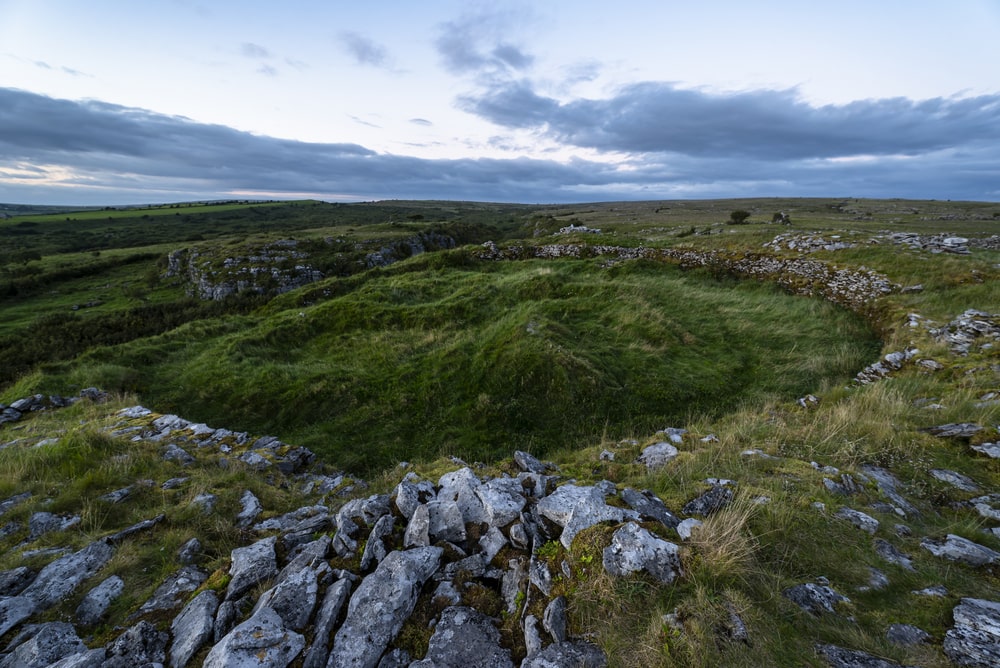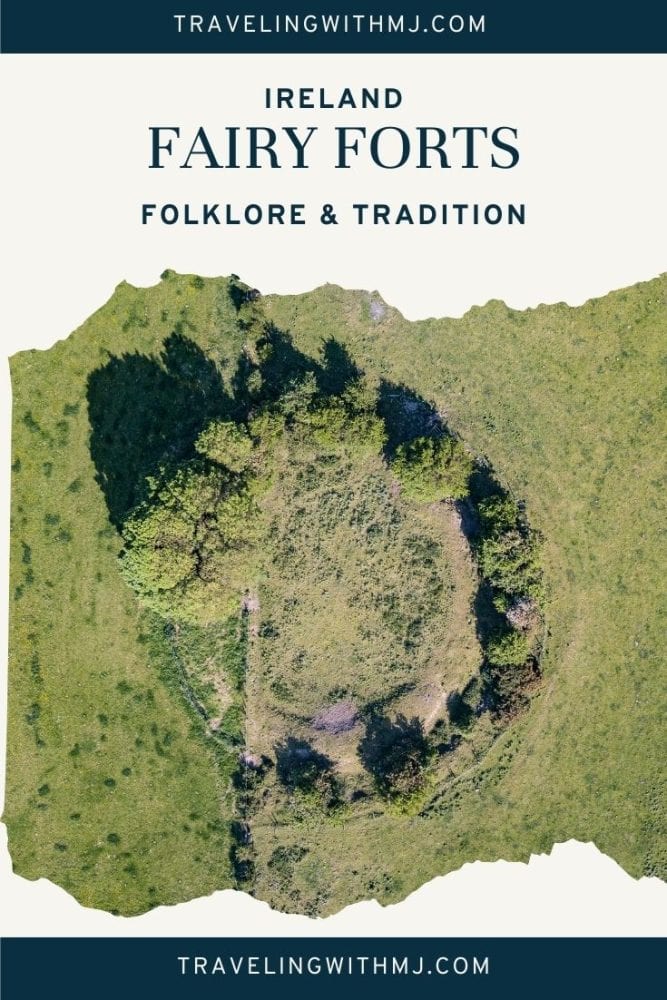Welcome to an exploration of Ireland’s intriguing fairy forts—a phenomenon deeply embedded in Irish folklore and tradition. These ancient remnants hold secrets and tales passed down through generations, sparking the curiosity of those seeking to unravel their mysteries. Join us as we delve into the world of Irish mythology and uncover the enigmatic structures that continue to captivate and inspire.

What is a Fairy Fort
A fairy fort, often referred to as a fairy ring fort, is an ancient archaeological site found across the landscapes of Ireland. These structures typically consist of circular earthen mounds or embankments and were built during the early medieval period. The ring forts were constructed using earth, stone, and sometimes timber, providing shelter for its inhabitants. Their circular design and the remnants of defensive features suggest a defensive purpose, offering protection to the people and livestock that resided within.
However, it’s their association with folklore, fairy tales, and the supernatural that adds a unique layer of intrigue to fairy forts.
In Irish mythology and tradition, these forts are believed to be inhabited by the fairies or the “sidhe,” a mystical and often mischievous supernatural race. The fairies are said to guard the numerous fairy forts, and disturbing or interfering with them could bring bad luck or consequences.
Many Irish people still hold these beliefs and respect the fairy forts, making them fascinating sites to explore, both for their historical significance and cultural reverence.
In other parts of the world, tales of fairies and other mythical creatures are strictly the contents of fiction and fables. But in Ireland, fairies are still very much part of reality, and denying their existence is believed by many to be a sure-fire way to end up cursed – or worse! Of course, along with the legends of fairies go the tales of fairy forts, and for many Irish believers, the remnants of fairy forts are sacred and ought not to be interfered with at any costs.
However, as many people who still cling to the mythical tales of fairies and fairy forts, others vehemently oppose the mere suggestion that fairies have any place in the real world. They explain so-called “curses” cast by fairies as mere coincidences, and the existence of fairy forts is chalked up to the construction of temporary prehistoric dwellings from the late Iron Ages to the early Christian era in the Irish countryside.
Unsurprisingly, both groups of believers and non-believers stand fairly firmly in their assertions. The former group are intent that denying the existence of fairies is a dangerous game, while the latter think that fairies and fairy forts are merely the subjects of old wives’ tales, and their so-called existence can be explained by means of historical enquiry and simple reason.
But what exactly are fairy forts and where do the legends come from? I’m going to explain the history of the emergence of Irish fairy forts themselves, as well as the magical mythology that surrounds their existence.
The History of Fairy Forts in Ireland
When the Irish talk about fairy forts, they’re referring to the remains of stones set out in a circular arrangement and surrounded by one or many ditches or banks. According to anthropological and archeological evidence and Irish history, they were built as forts or temporary dwellings, and they used to have wooden fences and structures too.
Historians estimate that there are between 30,000 and 40,000 identifiable fairy forts in rural Ireland, and the oldest ones date back to around 600 BCE. During this period, Ireland was mostly rural, and cattle was a major indication of wealth. So, naturally, protecting your cattle from predators, the elements, and even raids was a top priority, and fairy forts were constructed with this purpose in mind.
Over time, as permanent structures became more commonplace in Ireland, these types of forts were less popular, and eventually began to fall into disrepair. Historians believe this coincided with the Viking era and increase in the popularity of grain over cattle. However, while the topography of the landscapes and arrangements of the stones has stood the test of time in many cases – still observable to this day – other parts of the forts, including the wooden houses and fences, no longer exist.
But it wasn’t long before tales of the supernatural arose and threatening superstitions were associated with these forts. Around the 12th century, stories began to spread about bizarre, often frightening occurrences that had taken place at the sites of various old forts. Eventually the moniker of “fairy forts” took hold, evolving between the 12th and 19th centuries.
These tales described trespassers seeing ethereal-type beings, and in some cases, people seemingly being punished for changing or disturbing the structures. Although the evolution of the specific association with fairies, rather than general superstition, arose, but historical evidence shows that the legends of fairies and fairy forts had become fairly solidified in Irish folklore by the 19th century.
These legends from old times spread far and wide and are the foundation for the beliefs of many believers to this day.
The Magical Mythology of Fairy Forts
The first recorded tales about mysterious happenings at abandoned fairy forts tell the stories of people camping out at the abandoned forts and witnessing mysterious, ghostly figures – or spectral appearances.
Other stories of fairies speak of people who have moved to areas with old fairy forts on their land, and after having moved some of the stone structures – or attempting to, at the very least – succumbing to mysteriously violent ends or enduring painful injuries. Folklore dictates that these are the consequences enforced by the fairies, for tampering with their homes.
Another example involves a farmer in County Kerry, who decided to plow a field where a fairy fort stood. Shortly after disturbing the fort’s mound, his cattle fell ill, crops failed, and an unexplained string of misfortunes befell him. Convinced of the fort’s curse, he sought the help of a local priest to perform a ritual to appease the fairies and restore balance.
In another instance, a construction crew in County Limerick attempted to bulldoze a fairy fort to make way for a new road. Shortly thereafter, equipment malfunctions plagued the project, and a series of accidents befell the crew. Fearing the wrath of the fairies, the crew eventually abandoned their efforts to disturb the fort.
It should be evident that these Irish fairies from folklore are not the friendly magical creatures seen in children’s books and the likes of Peter Pan and Cinderella. Instead, many believe these fairies are life-sized, winged, supernatural beings who were once part of a God-like race who ruled ancient Ireland until retreating to the Underworld where they now live. Others simply liken them to evil spirits, equipped with magical powers and a disdain for being disturbed by the good people of the human world.
To this day, Irish folklore encourages people to stay away from fairy forts, fairy rings, any medieval ring fort, fair gardens, fairy mounds, fairy trees, and, if you can spot one, a fairy trail. In other words, leave the fairies in peace so as to avoid unpleasant interactions or potential physical harm. While many people don’t believe in the fantastical world of sinister fairies and mystical curses. those same people may still choose not to mess with a fairy fort.
What Does a Fairy Fort Look Like
If you fairy fort spotting, look for a circular mound, circular structures, or embankment found in the Irish landscape. Typically, it appears as a raised area, circular in shape, with clear signs of earth and sometimes stone construction. The structures can vary in size, ranging from small mounds to more substantial enclosures, depending on its historical and functional purpose.
The construction of a fairy fort typically consists of concentric earthen rings, forming a defensive-like structure. These rings are often discernible, displaying the layout of the fort. Some forts may have remnants of stone walls, providing additional structural support or delineation. The entrances, though less pronounced, are usually aligned with pathways or openings, indicating potential access points.
The overall appearance is that of a simple yet strategically designed circular mound, a fairy mound. The fort’s layout, consisting of concentric rings and earthwork, reflects a functional and pragmatic architectural approach that prevailed during the early medieval period in Ireland. Despite its simplicity, the fort’s historical and cultural significance contributes to its intriguing appearance and draws visitors to explore its enigmatic past.
Where to See a Fairy Fort
You can find fairy forts scattered across the Ireland, most particularly in rural and countryside areas. County Kerry, County Limerick, County Galway, and County Mayo are known to have several well-preserved sites.
Here are some well known and documented fairy forts to visit on your next trip to Ireland:
- In County Kerry, near Cahersiveen, travelers can visit Leacanabuaile Stone Fort. This particular site showcases a well-preserved ring fort with visible stone walls and earth embankments.
- In County Limerick, Grange Stone Circle is another noteworthy location, featuring a ring fort with an adjoining stone circle. This fort provides a prime example of the integration of ancient structures in Irish landscapes.
- County Galway boasts the impressive Caherconnell Stone Fort, a circular fort with excellent stone walls, providing insights into the architecture of that era.
- In County Mayo, tourists can visit the Céide Fields, a vast archaeological site with preserved ring forts that give visitors a sense of how these structures were integrated into the ancient agricultural landscape.
- In County Donegal, Grianan of Aileach is an ancient ring fort stands atop Greenan Mountain, offering panoramic views of the surrounding countryside. Built with dry stone walls, this circular structure is an impressive example of early Irish architecture, dating back to 1700 BC.
- In County Kerry, is the Cahergall Stone Fort. Situated on the famous Ring of Kerry, this fort stands as a testament to ancient Celtic construction. Its well-preserved dry stone walls and well-planned design make it a great stop for history enthusiasts.
- In County Clare, visitors can explore Cahercommaun Stone Fort, an circular fort in the Burren region (in top photo). This ancient structure showcases a remarkable layout with terraced stone walls, providing a glimpse into the architectural expertise of ancient Irish inhabitants.
Exploring these specific sites allows travelers to witness the physical remnants of Ireland’s history and heritage, offering a tangible connection to the past and the intriguing world of fairies.
Tips on Visiting a Fairy Fort
For many hundreds of years, tales of fairies and fairy forts have made up a significant part of Irish folklore and have dictated the dos and don’ts of how to behave in their presence. Visiting them in Ireland today can be an enriching experience, but regardless of what you believe, you should do so with respect and consideration for the cultural and historical significance of these sites.
First and foremost, researching specific locations and their accessibility is key. Many fairy forts are located in rural areas, so ensuring you have clear directions and necessary permissions to visit is essential. If on private property, get permission from property owners.
While exploring, it’s vital to follow designated paths and respect any signs or markers that may guide visitors around the site. Stepping off the marked paths or disturbing the fort’s structure is strongly discouraged, as it can disrupt the historical integrity of the location. Additionally, adhering to any posted rules, such as restrictions on climbing or touching the fort, is crucial to preserving these ancient sites for future generations.
In terms of etiquette, maintaining a quiet and respectful demeanor during your visit is important. Some locals may adhere to superstitions about disturbing fairy forts, so being considerate of these beliefs is courteous. Avoid leaving any litter behind and refrain from taking anything from the site.
By approaching these visits with a mindful and respectful attitude, you contribute to the preservation and continued appreciation of Ireland’s rich cultural heritage. And the fairy folk will appreciate your reverence as well.
Want more travel stories like this one? Subscribe to our bi-weekly newsletter here.
Disclosure: I visited Ireland as part of a sponsored campaign with Globus Journeys. Our tour was Green with Envy: Ireland by Design. You can find the 2024 tour details here.
Save to your favorite Pinterest boards



